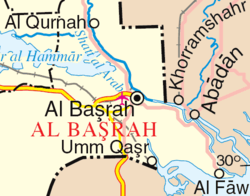Operation Samen-ol-A'emeh
| Operation Samen-ol-A'emeh | |||||||
|---|---|---|---|---|---|---|---|
| Part of Iran-Iraq War, Siege of Abadan | |||||||
 | |||||||
| |||||||
| Belligerents | |||||||
|
|
| ||||||
| Commanders and leaders | |||||||
|
|
| ||||||
| Units involved | |||||||
|
77th Infantry Division of Khorasan 36th Armoured Brigade of Shiraz Navy's Takavar Battalion[1] Separate brigades from IRGC Local volunteers IRIAA IRIAF | |||||||
| Strength | |||||||
|
50,000-60,000 troops Numerous armoured vehicles 200 artillery pieces | 15,000 troops inside Abadan, 20-30,000 troops outside | ||||||
| Casualties and losses | |||||||
|
1,500+ killed |
3,000 killed or wounded 150 tanks destroyed 9 AH-1J downed 2 CH-47 downed 3 Bell-214 downed | ||||||
Operation Samen-ol-A'emeh (Persian: عملیات ثامنالائمه "Operation Eighth Imam") was an offensive of the Iran-Iraq war between 27–29 September 1981 where Iran broke the Iraqi Siege of Abadan.
Prelude
see: Siege of Abadan
Diversionary Attack
On September 22, 1981, Iran began their first successful offensive against Iraq, in order to break the Siege of Abadan. The attack began with a diversionary operation. A combined arms force of 30–40,000 troops attacked the Iraqi forces in a wide front around the Karkheh river in Khuzestan province, Iran, aiming for the road towards Basra, Iraq. The Iranians used their regular army supported by Revolutionary Guard infantry, the former using small groups of armored vehicles with full artillery and air support (the Iranians had air superiority, but limited aircraft due to lack of spare parts). The operation convinced Iraq that Basra was under attack, consequently they did not reinforce their troops surrounding Abadan.
Main Attack
Two days later, Iran began to carry out their main offensive against Abadan. During the night, the Iranians infiltrated a force of 20–30,000 troops across the Bahmanshir River towards the Iraqi forces on the east bank of the Karun River around Abadan. The Iraqis failed to carry out adequate reconnaissance to discover the infiltration. The main attack was preceded by the Iranian air force carrying out airstrikes against the Iraqi troops between the Bahmanshir and the east bank of the Karun. Due to Iranian air superiority, the Iranians drove the counterattacking Iraqi jets away. On September 26, the Iranians ground forces attacked. The Iraqis were pinned down in their strongest positions, while their weakest positions were torn through, resulting in the isolation of many Iraqi forces. Iraq failed to maneuver their forces against the Iranians, and they stood in their static positions. An Iranian armored battalion cut the enemy forces in two, while AH-1 Cobra helicopters destroyed numerous Iraqi tanks using TOW missiles. Meanwhile, the siege of Abadan was broken, yet many Iraqi forces remained on the east bank of the Karun River, prevented from retreating after the Iranian air force bombed the bridges across the Karun River.
The next phase of the battle came when the Iranians unleashed their 92nd Armored Division on the north side of the Iraqi positions on September 27. The Iraqi command had been driven into a panic, and attempted a tactical withdrawal, which turned into a rout. The Iraqis abandoned their heavy weaponry, and fled across the river on a makeshift pontoon bridge and rafts.
Aftermath
Iran had scored a decisive victory. With a carefully planned operation and well executed use of their available materials, the Iranians routed a theoretically superior opponent. Nevertheless, on September 30, many important military commanders from the battle were killed when their C-130 Hercules crashed, including Mostapha Chamran. They had been instrumental with integration of the pre-revolutionary regular army's forces and the new Revolutionary Guards forces. In subsequent battles, on numerous occasions the combatants displayed a lack of coordination.
The victory at Abadan was an important morale booster for Iran, and an important stepping stone for the eventual ejection of the Iraqis out of Iran.
Saddam Hussein ordered the execution of seven commanders after the operation.[2]
Bibliography
References
- ↑ http://www.dolatebahar.com/view/205831/%D8%AF%D8%B1-%DA%AF%D9%81%D8%AA-%D9%88-%DA%AF%D9%88-%D8%A8%D8%A7-%D9%87%D9%88%D8%B4%D9%86%DA%AF-%D8%B5%D9%85%D8%AF%DB%8C%D8%8C-%D9%81%D8%B1%D9%85%D8%A7%D9%86%D8%AF%D9%87-%D8%AA%DA%A9%D8%A7%D9%88%D8%B1%D8%A7%D9%86-%D9%86%DB%8C%D8%B1%D9%88%DB%8C-%D8%AF%D8%B1%DB%8C%D8%A7%DB%8C%DB%8C-%D9%85%D8%B3%D8%AA%D9%82%D8%B1-%D8%AF%D8%B1-%D8%AE%D8%B1%D9%85%D8%B4%D9%87%D8%B1-%D9%85%D8%B7%D8%B1%D8%AD-%D8%B4%D8%AF-%DA%AF%D9%84%D8%A7%DB%8C%D9%87-%D9%87%D8%A7%DB%8C-%D9%86%D8%A7%D8%AE%D8%AF%D8%A7%DB%8C-%D8%AE%D9%88%D9%86%DB%8C%D9%86-%D8%B4%D9%87%D8%B1-%D8%A7%D8%B2-%DA%A9%DB%8C%D9%85%DB%8C%D8%A7-
- 1 2 http://www.tebyan.net/newindex.aspx?pid=8515